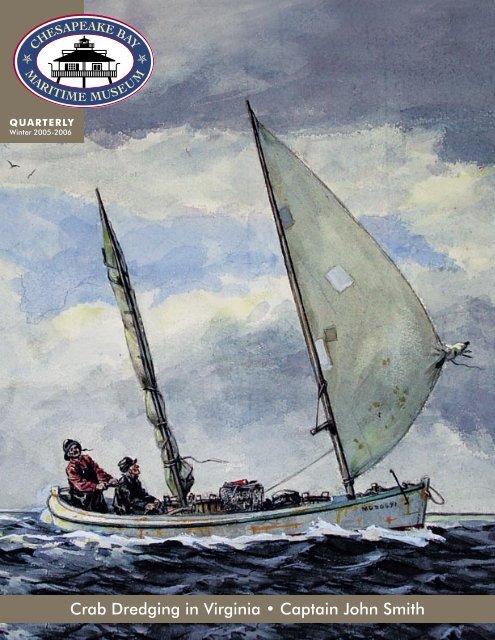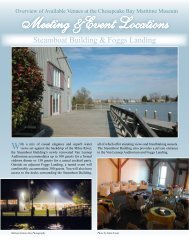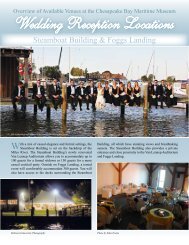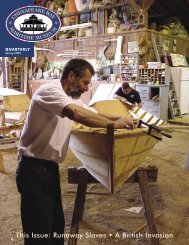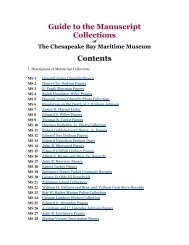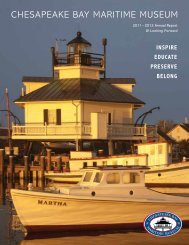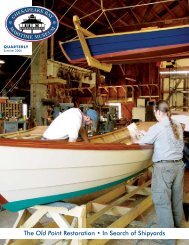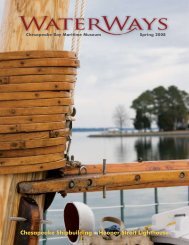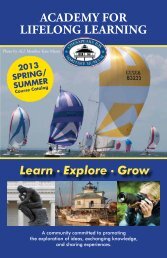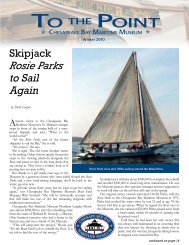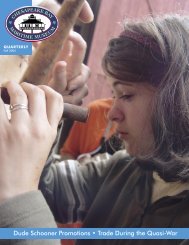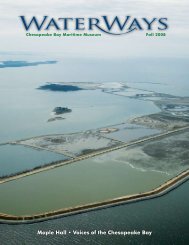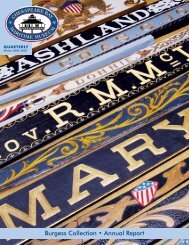Winter 2005-2006 - Chesapeake Bay Maritime Museum
Winter 2005-2006 - Chesapeake Bay Maritime Museum
Winter 2005-2006 - Chesapeake Bay Maritime Museum
Create successful ePaper yourself
Turn your PDF publications into a flip-book with our unique Google optimized e-Paper software.
QUARTERLY<strong>Winter</strong> <strong>2005</strong>-<strong>2006</strong>Crab Dredging in Virginia • Captain John Smith
President’s MessageQUARTERLY<strong>Winter</strong> <strong>2005</strong>-<strong>2006</strong>Volume 3 Number 4EditorMichael ValliantGraphic DesignRob Brownlee-TomassoContributorsKerry Wargo Clough,Cathy Connelly,Pete Lesher, Melissa McLoud,John Miller, Rachel Rébert,Lindsley Rice, Bob SavageLeigh Ann SchaeferAs you’ve read in the Chairman’s letter, I am stepping down as Presidentof the <strong>Chesapeake</strong> <strong>Bay</strong> <strong>Maritime</strong> <strong>Museum</strong>. I have accepted a new position asPresident of the Grayce B. Kerr Fund in Easton.I feel honored to be one of only two Executive Directors (now calledPresident) that the <strong>Museum</strong> has had in its forty-year history. I am proud ofthe prominence and stature that the <strong>Museum</strong> has achieved in my nineteenyears here. No one is more aware than I am that this success comes fromthe work we have done together—the staff I have worked with, the Board ofGovernors, our volunteers, our donors, and you, our members.With confidence, I can tell you that the <strong>Museum</strong> is positioned to continueits success well into the future. Our leadership, behind Chairman Jim Peterson,has outlined an exciting strategy, in the form of our newly adopted LongRange Plan, to help us realize our vision to be a premier museum, excelling incommunicating to the public the history and culture of the <strong>Chesapeake</strong> <strong>Bay</strong>.I have served with Jim Peterson in his various capacities as a Board memberfor more than eight years—an association for which I am professionally andpersonally grateful. I have told the Chairman and the Board that I will continuePhotographyRob Brownlee-Tomasso<strong>Chesapeake</strong> <strong>Bay</strong> <strong>Maritime</strong> <strong>Museum</strong>Navy Point, P.O. Box 636St. Michaels, MD 21663-0636410-745-2916 • Fax 410-745-6088www.cbmm.org • editor@cbmm.orgThe <strong>Chesapeake</strong> <strong>Bay</strong> <strong>Maritime</strong> <strong>Museum</strong> is a privatenot-for-profit 501(c)(3) educational institution. Acopy of the current financial statement is availableon request by writing the Vice President of Finance,P.O. Box 636, St. Michaels, MD 21663 or by calling410-745-2916 ext. 238. Documents and informationsubmitted under the Maryland Charitable SolicitationsAct are also available, for the cost of postage andcopies, from the Maryland Secretary of State, StateHouse, Annapolis, MD 21401, 410-974-5534.to serve as President until my successor is appointed. This will allow time tosearch for, and select, the right person to lead the <strong>Museum</strong> for perhaps thenext twenty years.Jim Peterson and I want to assure you that this process will benefit the<strong>Museum</strong>. Transitions are times of opportunity and growth. A transition likethis is ultimately less about particular people, and more about the health ofthe institution. The <strong>Museum</strong> is the strongest we’ve ever been—trends inmembership and attendance are up, our campus and visitor experience arecontinually improving, and you are about to see some remarkable programswith our changing exhibits.As we stated in our annual report: we have grown, but our mission remainsthe same. It has been my great pleasure to have played a part in the <strong>Museum</strong>’ssuccess, and now in seeing it continue to grow.On the CoverDetail from the watercolor painting, “AStormy Sky” by artist and illustratorLeonard W. Vosburgh (1912-1998). Alsocalled “Stiff Breeze,” the image depictstwo Maryland watermen sailing theirdouble-ended skiff full of crabbing gearunder reduced sail.John R. ValliantPresidentjvalliant@cbmm.org<strong>Chesapeake</strong> <strong>Bay</strong> <strong>Maritime</strong> <strong>Museum</strong> • <strong>Winter</strong> <strong>2005</strong>-<strong>2006</strong>
Visitors to the At Play on the <strong>Bay</strong>exhibit enjoy a vintage hydroplanebuilt by Larry Lauterbach.DepartmentsTo the PointProfileEvents Calendar912* Events Calendar is a special pull-outsection that can be found betweenpages 11 and 12.C 1-4FeaturesLeonard VosburghContentsArtist Leonard Vosburgh was known for his illustrations for numerousbooks and magazines. After a visit to Royal Oak in 1958, he began topaint scenes of the <strong>Chesapeake</strong> <strong>Bay</strong>. By Lindsley Rice.Canoeing on the <strong>Chesapeake</strong>Known more as cruising waters for sailboats, the <strong>Bay</strong> and its tributarieshave become increasingly popular for canoes and kayaks. Our At Playon the <strong>Bay</strong> exhibit chronicles a 1917 canoe trip. By Pete Lesher.Making DoMaryland and Virginia don’t agree. Scientists and watermen are at odds.There are merits and hazards to winter crab dredging. So what are theissues and where are the lines drawn? By Dr. Melissa McLoud.Discovering John Smith1318Historically, Captain John Smith has been overlooked or misinterpreted.On the eve of Jamestown’s 400th anniverary, a cooperative initiative isworking to rediscover Captain Smith. By Michael Valliant.Smith’s ‘Discovery Barge’4622John Swain, Drew McMullen, and the crew from Sultana Projects inChestertown have re-created the shallop John Smith used to explore the<strong>Bay</strong>. Next, they’re going to re-trace his voyage. By Taylor Buckley.Contents3
“Loose Mainsheet” captures Vosburgh’s illustrative story-telling ability at its best. CBMM collection.Vosburgh, himself a decoy collector, shows wonderful attentionto detail in this watercolor of a group of sports goingout on a skipjack towing hunting boats carrying decoys.CBMM collection.(Opposite) “Easing away from the Dock” shows a ramschooner being nudged away from the warehouse. A steamboatpasses in the background. In spite of the carefully observeddetail in this image, the name on the ram is fictional.CBMM collection.The figure of this hunter heading home with his prey is more impressionisticthan many of Vosburgh’s more carefully laid-downpaintings in which people appear as characters in a story. Thelooser brushstrokes here are more evocative of the cold grey morningand the movement of both the hunter and the wind through themarsh. CBMM collection.
By Lindsley Rice, CuratorReturning from a 1958 visit to Colonial Williamsburg,Leonard Vosburgh and his wife Alberta first visitedthe Eastern Shore. They became regular visitors to thePasadena Inn in Royal Oak, Maryland, and Vosburghbegan to paint <strong>Chesapeake</strong> scenes, at first for his ownenjoyment. He started to sell some of these imageswhen, as he remembered it, “the few grew into many—so many, we did not have room for them all.”Born in Yonkers, New York, Leonard Vosburghmade his living as a book illustrator—primarily ofchildren’s books set in America’s past. Vosburgh wasprolific in his field; he died in 1998 with illustrationsfor 90 books and numerous magazines to his name. Agraduate of the Pratt Institute and the Art StudentsLeague, Vosburgh studied under impressionistpainters and illustrators Walter Biggs and HarveyDunn, who also taught N.C. Wyeth. Dunn’s style wasmore dramatic and realistic, while Biggs depictedromanticized subjects in broad, colorful strokes.Vosburgh’s painting seems to draw from Dunn’spreference towards depicting everyday activities ofthe middle and working classes, but tinged with theidealism of Biggs’ more impressionistic work.Although often containing carefully observed detailsof <strong>Chesapeake</strong> people, craft, and environment, theimages Vosburgh painted were not truly drawn fromlife. Like his book illustrations, Vosburgh’s <strong>Chesapeake</strong>paintings depict an imaginary world—with fictionalpeople and vessel names. It is nevertheless a worldwhich reflects the artist’s love for this place and for aromanticized past, from around 1870 to 1930, which hedescribed as seeming “a more stable and gentler time.”


